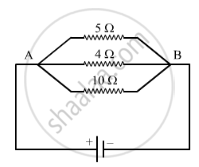Advertisements
Advertisements
Question
State whether the resistivity of a wire changes with the change in the thickness of the wire.
Solution
`R = (rhoL)/A`
`:. rho = (RA)/L`
`A = pir^2= (R(pir^2))/L`
⇒ Resistivity `ar^2 =>`Thus if thichkness increases resistivity increases.
APPEARS IN
RELATED QUESTIONS
In the circuit diagram given below, the current flowing across 5 ohm resistor is 1 amp. Find the current flowing through the other two resistors.

If the potential difference between the ends of a fixed resistor is halved, the electric power will become:
Define the following:
Potential difference
The voltage across a 3Ω resistance is 6 V. How large is the current? What is
the resistance of a filament lamp when a voltage of 3 V across it causes a
current of 0.5 A?
Calculate the current flowing through each of the resistors A and B in the circuit shown in the following figure.

Write an expression for the electrical power spent in flow of current through a conductor in terms of current and resistance.
From the following observations taken while determining the resistance of a conductor, draw the current-voltage graph and calculate the resistance of conductor. Is the conductor ohmic?
| Ammeter reading I (in ampere) | Voltmeter reading V (in volt) |
| 0.2 | 0.4 |
| 0.3 | 0.6 |
| 0.5 | 1.0 |
| 0.8 | 1.6 |
| 1.5 | 3.0 |
Potential near a charge is the measure of its ______ to bring a positive charge at that point.
Find out the following in the electric circuit given in Figure
- Effective resistance of two 8 Ω resistors in the combination
- Current flowing through 4 Ω resistor
- Potential difference across 4 Ω resistance
- Power dissipated in 4 Ω resistor
- Difference in ammeter readings, if any.

Twenty-seven drops of same size are charged at 220 V each. They combine to form a bigger drop. Calculate the potential of the bigger drop.
